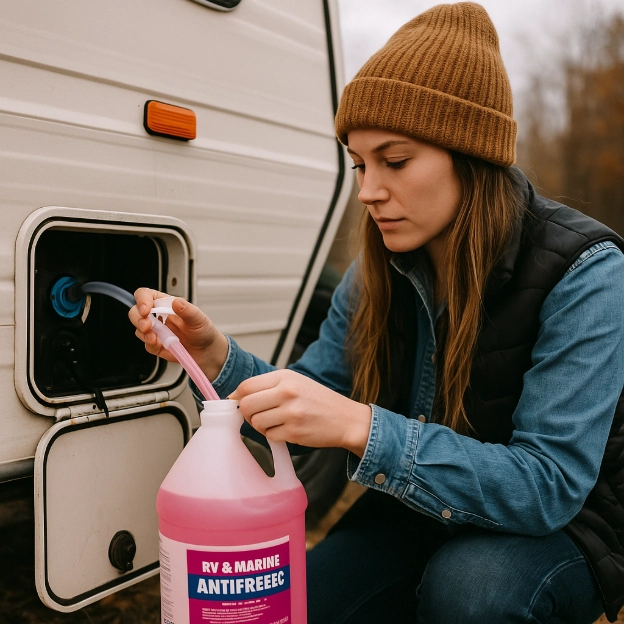How to Winterize Your RV: Essential Cold Weather Steps

-
Step-by-Step Guide: How to Winterize Your RV
-
1. Find Your Specific RV Manual
-
2. Locate and Understand Your Water Inlets
-
3. Set the Water Heater to Bypass Mode
-
4. Drain the Hot Water Tank
-
5. Drain and Flush the Entire Water System
-
-
6. Pump Antifreeze into the System
-
7. Winterize the Black Tank
-
8. Final Checks and Sealing
-
Alternatives to Antifreeze: Can You Winterize Without It?
-
Best Practices for Winterizing Your RV
-
After Winterizing: Should You Leave Faucets Open?
-
Winterizing the Black Tank: Don’t Forget This Crucial Step
Disclosure: Some of the links in this article may be affiliate links, which can provide compensation to me at no cost to you if you decide to purchase. This site is not intended to provide financial advice and is for entertainment only.
Winter is coming, and now is the time to start preparing your RV for the cold months ahead. Knowing how to winterize your RV is essential, whether you are an experienced RV owner or just starting out. Proper winterization helps you avoid costly damage and ensures your rig is ready for your next adventure when warmer weather returns. This step-by-step guide will walk you through everything you need to protect your RV from harsh winter conditions.
Step-by-Step Guide: How to Winterize Your RV
Winterizing your RV is an essential process to protect your investment from the harsh effects of freezing temperatures. This detailed guide will help you winterize your RV properly, ensuring it is ready to withstand the winter and be road-ready when the warmer months return. Check out our sister site blog post about spending the winter in your RV
1. Find Your Specific RV Manual
Before starting the winterization process, it is crucial to locate your RV’s specific manual. This manual provides essential information about your RV's plumbing system, including the location of water inlets, the hot water tank, and the bypass valves. Here is how you can find your RV manual:
Search Online: Most RV manufacturers offer digital versions of their manuals on their official websites. Search for your RV’s make, model, and year followed by "owner's manual" in your preferred search engine.
Manufacturer’s Website: Visit the manufacturer's website directly and look for a “Support” or “Resources” section where manuals are typically available.
Contact the Manufacturer: If you cannot find the manual online, contact the manufacturer’s customer service for assistance.
Once you have your manual, review it to familiarize yourself with the specific locations of the inlets, valves, and other components relevant to the winterization process.
2. Locate and Understand Your Water Inlets
Your RV has several water inlets that need to be drained and protected during the winterization process. The main ones to focus on are:
Fresh Water Inlet: This is where you normally connect your hose to fill the fresh water tank.
City Water Connection: This is where you connect to a water supply at an RV park or campground.
Water Heater Inlet: This is where water flows into your water heater.
Understanding the locations of these inlets is crucial as they will all need to be addressed during winterization.
3. Set the Water Heater to Bypass Mode
Most RVs are equipped with a water heater bypass valve. The purpose of this valve is to allow antifreeze to circulate through the plumbing system without entering the water heater, which would require a large amount of antifreeze. To set your water heater to bypass mode:
Locate the Bypass Valve: This is usually near the water heater itself. Your manual will have specific instructions on its location.
Turn the Valve: Switch the valve to the bypass position. This will prevent antifreeze from entering the water heater.
4. Drain the Hot Water Tank
Draining the hot water tank is a crucial step to prevent damage from freezing water. Here is how to do it:
Turn Off the Water Heater: Ensure that your water heater is turned off and has had time to cool down before draining.
Locate the Drain Plug/Anode Rod: The drain plug is typically at the bottom of the water heater, and in many RVs, this plug also serves as the anode rod.
Remove the Anode Rod: Use a wrench to unscrew the anode rod. This will allow the water to drain out of the tank. If your RV has a separate drain plug, remove that instead.
Inspect the Anode Rod: While you have it out, inspect the anode rod for wear. If it is significantly corroded, consider replacing it.
5. Drain and Flush the Entire Water System
Next, you need to drain the rest of the water system, including the fresh water tank, gray water tank, and black water tank. Here is the process:
Open All Faucets: Start by opening all the faucets in your RV to allow air to flow through and help drain the water.
Drain the Fresh Water Tank: Locate the drain valve on your fresh water tank and open it to release all the water.
Empty the Gray and Black Water Tanks: If you have not already, empty your gray and black water tanks at an appropriate dump station.
Flush the System: Once drained, flush out any remaining water using a water pump or by adding a small amount of antifreeze.
6. Pump Antifreeze into the System
With the water heater bypassed and the system drained, it is time to add RV-specific antifreeze to the plumbing system:
Connect a Pump Converter Kit: Attach a pump converter kit to your water pump. This kit allows you to draw antifreeze directly from its container into the RV’s plumbing system.
Open the Faucets: Starting with the closest faucet to the water pump, open the hot and cold faucets one at a time until you see antifreeze flowing out.
Flush the Toilet: Do not forget to flush the toilet until antifreeze appears in the bowl.
Run the Shower: Run both the hot and cold water in the shower until antifreeze flows through.
Remember the Exterior Shower: If your RV has an exterior shower or any additional water fixtures, ensure they are also winterized.
7. Winterize the Black Tank
The black tank needs special care during winterization:
Clean the Tank: If you have not already cleaned the black tank, use a tank cleaner specifically designed for RVs to remove any debris.
Add Antifreeze: Pour a few cups of antifreeze down the toilet and into the black tank to protect any residual water that may be left.
8. Final Checks and Sealing
Before you close up your RV for the winter, perform these final checks:
Seal Windows and Doors: Inspect all windows and doors for any gaps or cracks, and apply weather stripping or caulk as needed to prevent drafts.
Close All Faucets: Ensure all faucets are closed after antifreeze has been pumped through them.
Cover the RV: If possible, use a breathable RV cover to protect the exterior from snow, ice, and UV damage.
Alternatives to Antifreeze: Can You Winterize Without It?
While RV antifreeze is the most common method to winterize your RV, some owners prefer other methods. Here are a few alternatives:
Blow Out the Lines: Using an air compressor, you can blow out the water from your plumbing system.
Manual Draining: Some prefer to manually drain and leave the faucets open, though this method requires careful monitoring of the weather.
Best Practices for Winterizing Your RV
To ensure your RV is fully protected, follow these best practices:
Use RV-Specific Antifreeze: Always choose antifreeze designed for RVs.
Inspect and Repair: Fix any issues before they become bigger problems during the winter.
Check out this blog post about the best heater for RV living
After Winterizing: Should You Leave Faucets Open?
After you have winterized your RV, it is a good idea to leave the faucets open to avoid pressure build-up if any remaining water freezes.
Winterizing the Black Tank: Don’t Forget This Crucial Step
The black tank needs special attention. Make sure it is thoroughly cleaned and add antifreeze to prevent any residual water from freezing and causing damage.
With these steps, your RV will be well-prepared to face the winter, ensuring that when spring comes around, you are ready to hit the road again without any issues. Winterizing may seem like a daunting task, but with this guide, you can confidently protect your RV from the cold.
If you would rather not winterize your RV, follow me south for the winter. Here's a blog post about travelling solo to Mexico.
-
Step-by-Step Guide: How to Winterize Your RV
-
1. Find Your Specific RV Manual
-
2. Locate and Understand Your Water Inlets
-
3. Set the Water Heater to Bypass Mode
-
4. Drain the Hot Water Tank
-
5. Drain and Flush the Entire Water System
-
-
6. Pump Antifreeze into the System
-
7. Winterize the Black Tank
-
8. Final Checks and Sealing
-
Alternatives to Antifreeze: Can You Winterize Without It?
-
Best Practices for Winterizing Your RV
-
After Winterizing: Should You Leave Faucets Open?
-
Winterizing the Black Tank: Don’t Forget This Crucial Step
Disclosure: Some of the links in this article may be affiliate links, which can provide compensation to me at no cost to you if you decide to purchase. This site is not intended to provide financial advice and is for entertainment only.

